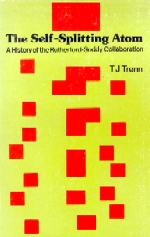|
The Self-Spilling Atom
The history of the Rutherford-Soddy collaboration
Thaddeus Trenn
 Taylor and Francis Ltd 1977
Taylor and Francis Ltd 1977
ISBN 0-85066-109-9
175 pages. Hard Cover.
21 black/white photos, 16 figures embedded in the text.
Purchasing Details.
Out of Print
My Comments on This Book
Norman Feather states in his forword "the collaboration of Rutherford and Soddy will for long remain the most interesting
of all collaborations. It has three aspects of uniqueness: the extreme youth of the collaborators, the entire novelty
of the field in which they were working and of the concepts which they developed, and the fact that over a period of
thirty years or more a fair share of the credit for their joint achievment was not universally accorded to one of them."
I dont fully agree with the latter statement. Soddy outlived Rutherford which is why this view came about.
Soddy had gone to Canada hoping to get a position at Toronto. On not doing so he went to a temporary position
at McGill, where he worked on the action of light on chlorine gas. The first Rutherford-Soddy interaction was in
1901 when they were on opposite sides of a discussion held by the McGill Physical Society.
Rutherford pointed out there were objects smaller than atoms, JJ Thomson's electron.
Soddy defended the integrity of the chemical atom. Rutherford was already on the way to transmutation,
having reported and studied the radioactive emanation of thorium, and had reported on the different lifetimes
of thorium and radium emanations, and also that the radioactivity "induced" by each element were different too.
Rutherford had his research students, such as Hannah Brooks, and his friend, the new professor of electrical
engineering who joined McGill at the same time as Rutherford, working on the problem. Following the McGill Physical
Society discussion, Rutherford, who had been turned down by another friend, the new chemistry professor (an organic
chemist) who joined McGill at the same time as Rutherford, invited Soddy to join him in working out the
chemistry of the emanations.
Errors Noted.
None noted
back to top
Contents
| Foreword |
Norman Feather |
vii
|
| Preface |
|
ix
|
| Acknowledgements |
|
x1
|
| Chapter |
|
|
| 1 |
The Collaboration Epitomized |
1
|
| 2 |
Background to the Collaboration |
10
|
| 3 |
Emanation |
36
|
| 4 |
An Explanation of Radioactivity |
49
|
| 5 |
Further Problems |
72
|
| 6 |
Wider Implications |
88
|
| 7 |
Theoretical Difficulties |
107
|
| 8 |
Confirmation and Reflections |
124
|
| 9 |
Significance of the Self-Splitting Atom |
142
|
| Appendix 1 |
Dating the Addendum of Rutherford and Soddy |
148
|
| Appendix 2 |
Thorium and Uranium Decay |
152
|
| Appendix 3 |
Probability and the Disintegration Theory |
156
|
| Bibliography |
Works Cited by Short Title |
160
|
| Who's Who for 1903 |
|
160
|
| Index of Persons |
|
170
|
| SubjectIndex |
|
173
|
back to top
Reviews
Not known at this stage.
|

